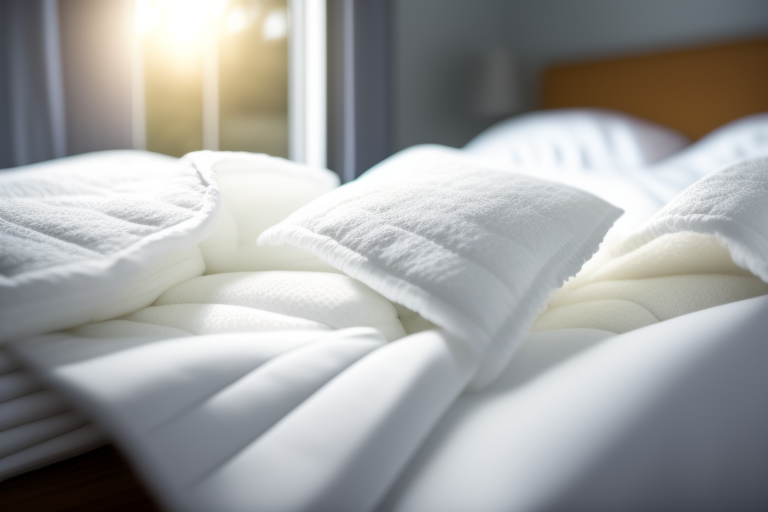Are you considering investing in a down-filled comforter but unsure how long it will realistically last? With proper care and maintenance, a high-quality down comforter can last over a decade. But there are many factors that determine longevity.
This beginner’s guide will walk you through everything you need to know about down comforter lifespan and durability, from construction to signs of wear and tear. You’ll also get tips on choosing the best down comforter to maximize longevity and get your money’s worth.
What is a Down Comforter?
Before diving into lifespan, let’s review what exactly a down comforter is.
A down comforter consists of the following components:
- Outer shell – Typically made of cotton, cotton blend, or microfiber materials. The shell contains the down fill.
- Fill material – Down comforters are filled with goose or duck down clusters and feathers.
- Baffle box construction – The shell is divided into compartments, called baffles, that prevent fill from shifting.
Down clusters provide unmatched insulation and loft. This creates a light, fluffy comforter that keeps you warm without excess weight.
Why Down Comforter Lifespan Matters
Down comforters represent a significant investment. Prices range from $100 on the low end, up to $1000+ for premium quality.
Understanding longevity helps ensure you get your money’s worth from the purchase. It also guides you in choosing the best down comforter that will last.
Now let’s explore the key factors that determine down comforter lifespan.
Factors That Impact Down Comforter Longevity
Many variables influence how long a down comforter will last before requiring replacement. The main factors include:
Down Fill Power and Quality
- Fill power measures volume and loft. Higher fill power down occupies more space, creating more insulation.
- Comforters with 600 to 800 fill power last the longest. Lower fill power compacts down more quickly.
- Down quality also affects durability. Go for comforters with a 75% down minimum. Lower percentages add more feathers, which are less resilient.
Shell Fabric Durability
- The outer shell protects and contains the fill. Look for long-lasting cotton, cotton blend, or microfiber shell materials.
- Thread count impacts strength. Shells with a thread count between 300-600 offer the best durability.
- Weave is also important. Percale or sateen shells hold up better than flimsy plain weaves.
Construction and Stitching
- Tightly stitched baffle boxes prevent fill shifting and clumping. They keep insulation evenly distributed.
- Double needle stitching makes seams stronger and more durable. Avoid comforters with weak single stitching.
- Look for 8-12 inch baffle widths. Narrow baffles limit fill movement better than wide baffles.
Care and Maintenance
- Frequent cleaning maintains loft and prevents compacting. Wash every 3-6 months.
- Use front-loading washers and gentle cycles. Agitation preserves fill quality.
- Low heat drying on delicate prevents damage to down clusters.
Proper care is vital for maximizing the lifespan of a down comforter.
Now that you know what affects longevity, let’s look at how to estimate lifespan.

How Long Do Down Comforters Last?
With regular care, a high quality down comforter can last 10-15 years on average. Some factors that influence lifespan include:
- Fill power – Comforters with 600-800 fill power last the longest.
- Down percentage – Aim for 75% down minimum for optimal resilience.
- Shell fabric – Cotton, cotton blend, and microfiber shells are most durable.
- Construction – Tightly stitched baffles and reinforced seams prolong lifespan.
- Care – Frequent washing and low heat drying keeps down lofted.
Signs of wear appear gradually. Being able to identify them guides you when it’s time to replace your comforter.
Signs Your Down Comforter Needs Replacing
Monitor your comforter for these signs of wear indicating loss of lifespan:
- Visible holes, tears, or rips – Shell damage allows fill to escape.
- Broken baffle walls – Fill shifts and clumps when baffles are compromised.
- Crusty down clusters – Moisture damage causes down to clump together.
- Sparse or thinned sections – Fill compacts down or escapes over time.
- Reduced warmth – Less loft means less insulation and warmth.
Minor deterioration is normal over time. But once wear impacts structure, warmth, or fill containment, it’s time to replace your comforter.
Ideally, your comforter will last 10+ years with proper maintenance before these major signs appear. Next, let’s go over care and tips to maximize lifespan of your down comforter.
Caring for Your Down Comforter
You can extend the life of your comforter with proper maintenance:
- Wash 2-3 times per year – Cleaning removes built-up oils that cause clumping. Use a front-loading washer and delicate cycle.
- Dry thoroughly on low – Insufficient drying allows moisture damage. Low heat prevents fill damage.
- Fluff regularly – Shake and redistribute fill to prevent compacting.
- Use a duvet – Protects the comforter from body oils and dirt.
- Avoid direct sun exposure – Sunlight damage can dry out shell and down material.
Proper care removes the oils, dirt, and moisture that compact down clusters over time. Follow these best practices to enhance longevity.
Next, let’s compare down with alternative fills to see which offers better durability.
Down vs. Alternative Comforter Longevity
Down alternative comforters are usually filled with polyester fibers. Here is how they compare:
- Down lasts significantly longer than alternative fills. The natural clusters maintain loft and insulation better long-term.
- Alternative materials tend to flatten and clump more quickly. They degrade faster than feather and down clusters.
- However, alternative comforters are cheaper upfront. Expect to replace them more often.
While down comforters come with a higher initial investment, their superior durability offers better value in the long run.
Is a Down Comforter a Smart Investment?
Let’s examine the return on investment of purchasing a down comforter:
- The lifespan of a quality down comforter is approximately 10-15 years with proper care.
- Budget down comforters start around $100-$200. High-end options run $600+.
- Down alternatives usually cost $50-$150 but only last 2-5 years.
- Over a 15-year period, a $400 down comforter would cost around $27 per year.
- Buying a $100 alternative every 5 years costs $20 per year but provides less warmth and comfort.
So while down comforters are pricier upfront, their longevity provides better long-term value compared to disposable alternatives you replace frequently.
How Does Shell Fabric Impact Longevity?
The outer shell plays an important role in lifespan and preventing fill escape.
- Cotton shells are very breathable and durable. Pima or Egyptian cotton offers longevity.
- Cotton/polyester blends add strength while retaining breathability.
- Microfiber is lightweight, soft, and smoothing. It’s prone to pilling.
- Silk looks luxurious but is delicate and less durable.
- Flannel provides extra coziness but wears faster than cotton.
For best results, look for a 300-600 thread count cotton or cotton blend shell. The tight weave contains fill securely over the long run.
Avoid shells like silk or flannel that compromise durability despite their pleasing aesthetics.
Does Fill Power Impact Longevity?
Down comforters with higher fill power tend to last longer:
- Higher fill power down (600-800) lofts better and resists flattening.
- Lower fill powers below 500 are heavier and prone to compacting.
- However, extremely high fill powers above 800 can overload baffles, causing them to tear.
- The ideal balance for longevity is comforters with 600-800 fill power.
Aim for the optimal range of fill power. Too low reduces insulation over time, while too high risks rupturing the baffle walls.

Identifying a High Quality Down Comforter
Since quality plays a key role in longevity, here are signs you’ve found a good down comforter:
- 75% down minimum – Higher percentages of down last better than more feathers.
- Tight, reinforced baffle walls – Prevents fill shifting and maintains even distribution.
- Woven fabric shell – Not printed. Tightly woven shells don’t allow fill escape.
- Reinforced stitching – Double needle stitching makes seams more durable.
- Responsive seller – Provides info on fill percentages, origins, cleaning methods.
- Fill power of 600-800 – Enough loft for warmth and longevity without overloading baffles.
- Cotton or cotton blend shell – More durable than microfiber or silk.
- Multiple size options – Comes in all standard sizes rather than one-size.
- Oeko-Tex certification – Guarantees no harmful chemicals were used.
Selecting a high-quality down comforter right off the bat ensures it will last you many years before needing replacement.
When Is It Time to Replace Your Down Comforter?
It can be difficult to determine when it’s finally time to retire your beloved down comforter and purchase a replacement. Here are key signs to look for:
- Noticeable holes, rips, or tears in the shell allowing fill to escape.
- Broken baffle walls resulting in shifting fill and cold spots.
- Severe clumping where down no longer lofts and insulates.
- Thin spots where fill is severely depleted.
- No longer provides warmth due to degraded fill quality.
- Repeated cleaning no longer restores fluff. Fill is packing down.
Minor deterioration is normal but once problems become irreversible, it’s time to replace the comforter. Most people find 10-15 years is the maximum lifespan of a quality down comforter with proper maintenance.
Takeaways on Down Comforter Lifespans
Caring for a down comforter properly allows it to remain fluffy and warm for over a decade. To recap the key points:
- Focus on high fill power between 600-800 and 75% down or higher.
- Choose a tightly woven cotton or cotton blend shell for durability.
- Well-constructed baffles and reinforced seams prevent fill shifting.
- Clean 2-3 times per year and dry thoroughly on low to avoid damage.
- Fluff and redistribute fill monthly to prevent clumping and compaction.
- Look for signs of deterioration like holes, thinning, reduced warmth.
While the initial cost is higher, a quality down comforter provides unbeatable comfort and durability for many years when properly cared for. Make your purchase an investment by selecting the right materials and construction.
Frequently Asked Questions
How often should you replace your down comforter?
With proper care, you can expect your down comforter to last between 10-15 years before needing replacement. Follow the cleaning, drying, and storage tips in this guide to maximize longevity.
What impacts down comforter durability?
The biggest factors affecting durability are the fill power, down percentage, shell fabric, and stitching quality. Avoid low fill power down and delicate shell fabrics. Opt for tightly constructed comforters with reinforced seams.
How do I maintain down comforter loft?
Frequent washing and drying on low heat will restore loft and prevent compacting. Fluff the comforter daily and redistribute the fill to prevent clumping. Use a duvet cover to protect from oils and dirt.
Why does my comforter have thin spots?
Thin spots indicate your down comforter is at the end of its lifespan. The fill has likely shifted or degraded, leaving certain sections with less insulation. This results in cold spots and reduced warmth.
How can I improve down comforter longevity?
Follow the care instructions to wash and dry properly 2-3 times per year. Store the comforter loosely rather than compressed. Fluff and shake it regularly to maintain even fill distribution. Use a duvet cover to protect the shell fabric from wear.








